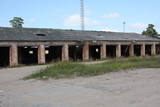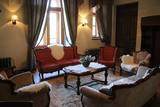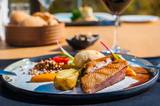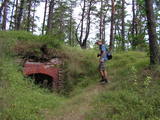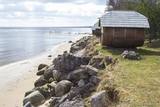| Нo | Название | Описание |
|---|---|---|
|
This is Latvia’s largest small-leaved lime tree (Tilia cordata). Some of its mighty branches are held up by supports. There are large holes in the trunk that have been covered up to prevent water entering the holes and causing even more rot. Just like many other trees of this size, this was a sacred tree in the past
|
||
|
Aptuveni 0,5 km dienvidos no Mežotnes pilskalna atrodas Vīna kalns, kas līdzīgi kā Mežotnes pilskalns, ir veidots, izmantojot Lielupes ielejas stāvās krastu nogāzes, tās pārveidojot. Vietvārds ir it kā radies no stāsta, ka šeit parādījies dievgalds ar maizi un vīnu. Vīna kalnu ar Mežotnes pilskalnu savieno jauka koka laipa, kas ved pa Lielupes ielejas pamatkrasta lejas daļu. |
||
|
Diplomēts mežsaimnieks Imants Urpens Alojas novada "Ošlejās" audzē šitaki sēnes. Šī ir arī mācību saimniecība, uz kuru brauc mācīties pārsvarā ārzemnieki. Saimniecība ir bioloģiski sertificēta. Pieņem ekskursijas un pasūtījumus sēņu audzēšanai un micēlija iegādei. |
||
|
В восстановленном по инициативе Беверинского общества ремесленников домике предлагают продукцию ремесленников края и более обширной местности, творческие мастерские и мероприятия по освоению техник всевозможного рукоделия. Домик – это и учебный центр, и лавка для торговли изделиями ремесленничества, и Центр популяризации культуры, фольклора и латышской идентичности Беверинского края |
||
|
Гостевой дом находится в 300-летнем здании пивоварни Омульского фольварка, расположенного в 20 км от Валки. Хозяйство занимается производством домашних копченостей, сыров, белого хлеба, кисло-сладкого и ржаного хлеба. Подворье со скотом, баня. |
||
|
В советские времена в Вентспилской танковой части располагался учебный полк. В наши дни объект деградирует, а обслуживаются только ремонтные и хозяйственные здания бывшей танковой части. Остальная территория не используется и не охраняется.
|
||
|
The “backbone” to this park is the valley of the Šventoji (Holy) River. One of the most impressive Devonian cliffs in Lithuania can be seen from the river – Vetygalos atodanga. On the shores of the Varius stream is a cliff made of quartz and sand – Variaus atodanga. 6 km to the S of Anykščiai is Lithuania’s second largest rock (5.7 m high, ~100 m3) – Puntukas akmuo.
|
||
|
С XV века в Приекуле правил род баронов Корфов. Один из них – Иоганн Альберт Корф (1697 - 1766.) был президентом Петербургской Академии наук (1734 - 1740 гг.), дипломатом и литератором, который занимался исследованием истории Курземе. Приекульский замок находится на западе от улицы Айзпуте, на берегу реки Вирга. Первоначально дворец господской усадьбы построили в XVIII веке, а в конце XIX века велись большие работы по перестройке здания (проект Пауля Макса Берчи). В здании находится Приекульская средняя школа. Примерно в 100 м к востоку от господской усадьбы возвышается смотровая башня усадьбы (построена в конце XIX века), над которой развевается государственный флаг Латвии. |
||
|
Создан в 900 году у места впадения речки Персес в Даугаву (теперь – в водохранилище Плявиньской ГЭС), в нем можно осмотреть шведские пушки 17 века и памятники средневековых могил. В парке (перед школой) находится восстановленный фонтан „Голова фавна”, который в тридцатые годы 20 века находился недалеко от легендарного водопада Персес (сейчас под водой), место которого обозначено расположенной на берегу реки каменной скульптурой „Девушка Персе” (автор: Я. Зихманис). Дорожка ведет вдоль 11-метровой деревянной скульптуры «Вечности», созданной скульптором Г.Бурвисом, и созданной братьями Руранами «Совушки». |
||
|
Из выросших на красивейшей возвышенности Вырумаа ягод и фруктов хозяева готовят вино, знакомят со своим садом и процессом приготовления вина, организуют дегустацию и курсы. |
||
|
The castle was built as an almost exact copy of the architecture of Windsor Castle in the UK and is among the most unusual of the Estonian manor buildings. At least as interesting is the owner and initiator of the manor building design - Count Friedrich von Berg. There is also a Dendro park with rare species behind the Castle. |
||
|
Ресторан находится в первой в Латвии пятизвездочной гостинице, расположенной за чертой города, в красивом месте с историей и будущим ‒ в Аматциемсе. При приготовлении блюд повара используют местные, выращенные натуральным способом продукты, и подают их в современной интерпретации, делая акцент на вкусе и качестве. |
||
|
Lina, vilnas apģērbu šūšana, galdautu, dvieļu, jostu u.c. tekstilizstrādājumu šūšana. Tērpu darināšana nav tikai darbs, bet arī aicinājums. Tas palīdz izgatavot vissarežģītākās tērpu konstrukcijas. Nemitīgā zināšanu papildināšana kursos ļauj veiksmīgi dzīvot līdzi mainīgajām modes prasībām. Paralēli individuālajiem pasūtījumiem tiek izgatavoti gan apģērbi, gan citi šūtie izstrādājumi tirdzniecībai. |
||
|
Форты строились и преобразовывались на протяжении длительного времени. К строительству фортов руку приложили и немцы, и шведы, и русские. В начале 20 столетия, в 1912 году началось строительство нескольких фортов в Мангальсале и Болдерае. Было построено два форта с 254-мм орудиями, шесть фортов со 152-мм орудиями и три форта со 138-мм орудиями. В каждом форте было установлено по две пушки. Система фортификации Мангальсалы состоит из нескольких частей и раскинулась на довольно широкой территории. Отдельные части системы недоступны, т.к. располагаются на территории садовых участков. Это уникальный исторический памятник, расположенный в столице государства, но в тоже время и забытый, и неухоженный, и труднодоступный, и опасный для посещения. В случае если объект будет оценен по достоинству и ухожен, в будущем он может стать одним их топовых туристических объектов в Риге, ведь Рига – это не только старый город (Вецрига) ...
|
||
|
This is the only place in the Baltic States where there is such a vast territory of open-air sand dunes which still change the local terrain very actively because of the wind. The only Sea Museum and Dolphinarium in the Baltic States can be found here.
|
||
|
Старинный ливский поселок, ливское название которого Mustanumm. Еще в середине 20-го века здесь жили ливы. В поселке Мелнсилс у впадения речки Бакупите в Рижский залив представители семейств Ландманисов, Морицов и Отомеров построили три парусника. В поселке находятся два культурно-исторических места: церковная гора Бакю – древнее культовое место и городище пирата Троммеля. (Источник: Ройский ТИЦ) |
||
|
One of the most unusual houses of worship in the national park, this one has a red brick tower, and together with local residential buildings it makes up an interesting cultural landscape. The prayer house is not open to the public. |
||
|
Ģimenes uzņēmums Svētes pagastā, netālu no Jelgavas. Kopš 2019.gada šeit top dažādi Latvijas priežu produkti, kas vērtīgi kā imunitātei, tā arī veselībai. Mītavas Čiekurs produktu galvenā sastāvdaļa ir Parastā priede (Pinus sylvestris). Tā bagāta ar ēterisko eļļu, sveķiem, miecvielām, C vitamīnu u.c. vērtīgām vielām. Tiek gatavotas priežu čiekuru karameles, čiekuru sīrupa zefīri, želejkončas, priežu čiekuru zapte, karamelizēti čiekuri sīrupā, šokolādē, kā arī priežu pumpuru sīrups un tēja. Ekskursija norisinās 90-120 minūtes, kuru laikā atraktīvais saimnieks Reinis pastāstīs par uzņēmuma vēsturi, dalīsies receptēs, pagatavos katram apmeklētājam gardu dāvanu (čiekuru marmelādi), kā arī protams- varēs degustēst dažādos priežu produktus. Papildu pirms vai pēc ekskursijas iespējams ieturēties ar uz ugunskura gatavotu pupiņu zupu ar lauku kūpinājumiem, soļanku vai biešu zupu. Tūristus uzņem nupat uzbūvētajā ekskursiju telpā- Čiekurnīcā. Uzņemt var līdz pat 60 interesentiem reizē. |
||
|
В усадьбе есть возможность осмотреть гордость усадьбы – погреб с накопленной в нем большой коллекцией вин, изготовленных на ферме. На ферме можно приобрести вино из яблок, винограда, вишни, черной смородины, клюквы, крыжовника, ревеня. |
||







